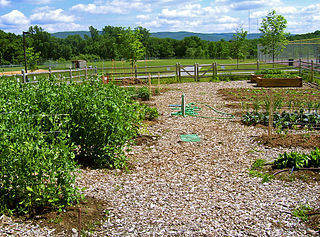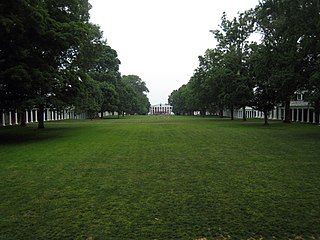The International Treaty on Plant Genetic Resources for Food and Agriculture, is a comprehensive international agreement in harmony with the Convention on Biological Diversity, which aims at guaranteeing food security through the conservation, exchange and sustainable use of the world's plant genetic resources for food and agriculture (PGRFA), the fair and equitable benefit sharing arising from its use, as well as the recognition of farmers' rights. It was signed in 2001 in Madrid, and entered into force on 29 June 2004.

The following outline is provided as an overview of and topical guide to organic gardening and farming:

A lawn is an area of soil-covered land planted with grasses and other durable plants such as clover which are maintained at a short height with a lawnmower and used for aesthetic and recreational purposes—it is also commonly referred to as part of a garden. Lawns are usually composed only of grass species, subject to weed and pest control, maintained in a green color, and are regularly mowed to ensure an acceptable length. Lawns are used around houses, apartments, commercial buildings and offices. Many city parks also have large lawn areas. In recreational contexts, the specialised names turf, pitch, field or green may be used, depending on the sport and the continent.

Victory gardens, also called war gardens or food gardens for defense, were vegetable, fruit, and herb gardens planted at private residences and public parks in the United States, United Kingdom, Canada, Australia and Germany during World War I and World War II. In wartime, governments encouraged people to plant victory gardens not only to supplement their rations but also to boost morale. They were used along with rationing stamps and cards to reduce pressure on the food supply. Besides indirectly aiding the war effort, these gardens were also considered a civil "morale booster" in that gardeners could feel empowered by their contribution of labor and rewarded by the produce grown. This made victory gardens a part of daily life on the home front.

Guerrilla gardening is the act of gardening – raising food, plants, or flowers – on land that the gardeners, do not have the legal rights to cultivate, such as abandoned sites, areas that are not being cared for, or private property. It encompasses a diverse range of people and motivations, ranging from gardeners who spill over their legal boundaries to gardeners with a political purpose, who seek to provoke change by using guerrilla gardening as a form of protest or direct action. This practice has implications for land rights and land reform; aiming to promote re-consideration of land ownership in order to assign a new purpose or reclaim land that is perceived to be in neglect or misused. Some gardeners work at night, in relative secrecy, in an effort to make the area more useful or attractive, while others garden during the day for publicity.

A community garden is a piece of land gardened or cultivated by a group of people individually or collectively. Normally in community gardens, the land is divided into individual plots. Each individual gardener is responsible for their own plot and the yielding or the production of which belongs to the individual. In collective gardens the piece of land is not divided. A group of people cultivate it together and the harvest belongs to all participants. Around the world, community gardens exist in various forms, it can be located in the proximity of neighborhoods or on balconies and rooftops. Its size can vary greatly from one to another.

Natural landscaping, also called native gardening, is the use of native plants including trees, shrubs, groundcover, and grasses which are local to the geographic area of the garden.

Urban horticulture is the science and study of the growing plants in an urban environment. It focuses on the functional use of horticulture so as to maintain and improve the surrounding urban area. Urban horticulture has seen an increase in attention with the global trend of urbanization and works to study the harvest, aesthetic, architectural, recreational and psychological purposes and effects of plants in urban environments.
Prefigurative politics are the modes of organization and social relationships that strive to reflect the future society being sought by the group. According to Carl Boggs, who coined the term, the desire is to embody "within the ongoing political practice of a movement [...] those forms of social relations, decision-making, culture, and human experience that are the ultimate goal". Besides this definition, Leach also gave light to the definition of the concept stating that the term "refers to a political orientation based on the premise that the ends a social movement achieves are fundamentally shaped by the means it employs, and that movement should therefore do their best to choose means that embody or prefigure the kind of society they want to bring about". Prefigurativism is the attempt to enact prefigurative politics.
Constructive Program is a term coined by Mahatma Gandhi to describe one of the two branches of his satyagraha, the other being some form of nonviolent resistance, e.g. civil disobedience. The value of a Constructive Program in the struggle for the independence of India cannot be overemphasized, as Gandhi described civil disobedience as "an aid to constructive effort." Gandhi wrote to his friend and supporter, Jamnalal Bajaj, saying, "My real politics is constructive work." Gandhi's constructive work included a campaign for people to spin their own cloth at home and mine their own salt to avoid having to buy from the British in their anti-colonial struggle.

Emma Prusch Farm Park is a 43.5 acre park in East San Jose, California. Donated by Emma Prusch to the City of San Jose in 1962 to use to demonstrate the valley's agricultural past, it includes a 4-H barn, community gardens, a rare-fruit orchard, demonstration gardens, picnic areas, and expanses of lawn. The park is host to an annual Harvest Festival and is operated cooperatively by the San Jose Parks and Recreation Department and the non-profit Emma Prusch Farm Park Foundation.

Fritz Haeg is an American artist whose work spans a range of disciplines and media including gardens, dance, performance, design, installation, ecology and architecture, most of which is commissioned and presented by art museums and institutions. His work often involves collaboration with other individuals and site specific projects that respond to particular places.

A weed is a plant considered undesirable in a particular situation, growing where it is not wanted. The concept of weeds is particularly significant in agriculture, where the aim is growing crops or pastures of a single species, or a mixture of a few desired species. In such environments, other plant species are considered undesirable and therefore weeds. Besides, some weeds have undesirable characteristics making them a plant pest in most human settings.

The White House has had multiple vegetable gardens since its completion in 1800. Eleanor Roosevelt, Hillary Clinton and Michelle Obama all have had their own versions of vegetable gardens. Roosevelt planted the White House victory garden during World War II to promote the use of victory gardens by American citizens in a time of possible food scarcity. Hillary Clinton had a vegetable garden constructed on the roof of the White House. On March 20, 2009, Michelle Obama broke ground on the largest and most expansive vegetable garden to date on the White House lawn.

Seed swaps are events where gardeners meet to exchange seeds. Swapping can be arranged online or by mail, especially when participants are spread out geographically. Swap meet events, where growers meet and exchange their excess seeds in person, are also growing in popularity. In part this is due to increased interest in organic gardening and heritage or heirloom plant varietals. This reflects gardeners' interest in "unusual or particular varieties of flowers and vegetables", according to Kathy Jentz of Washington Gardener Magazine (Maryland).

The Bay View Garden And Yard Society is a nonprofit 501(c)(7) organization based in the Bay View neighborhood of Milwaukee, Wisconsin, United States.

Community gardens in the United States benefit both gardeners and society at large. Community gardens provide fresh produce to gardeners and their friends and neighbors. They provide a place of connection to nature and to other people. In a wider sense, community gardens provide green space, a habitat for insects and animals, sites for gardening education, and beautification of the local area. Community gardens provide access to land to those who otherwise could not have a garden, such as apartment-dwellers, the elderly, and the homeless. Many gardens resemble European allotment gardens, with plots or boxes where individuals and families can grow vegetables and flowers, including a number which began as victory gardens during World War II. Other gardens are worked as community farms with no individual plots at all, similar to urban farms.

Foodscaping is a modern term for the practice of integrating edible plants into ornamental landscapes. It is also referred to as edible landscaping and has been described as a crossbreed between landscaping and farming. As an ideology, foodscaping aims to show that edible plants are not only consumable but can also be appreciated for their aesthetic qualities. Foodscaping spaces are seen as multi-functional landscapes which are visually attractive and also provide edible returns. Foodscaping is a great way to provide fresh food in an affordable way.

Renée Gunter is an American landscape designer based in Los Angeles, California. She is notable for drought-tolerant gardens.
Keep Growing Detroit is an organization dedicated to food sovereignty and community engagement in the cities of Detroit, Hamtramck, and Highland Park. Founded in 2013, the program designs and implements initiatives that promote the practice of urban agriculture as a mode of food justice for underrepresented communities, particularly those who do not have access to healthy food options. The goals of Keep Growing Detroit are to educate and empower community members using urban agricultural practices. Programs such as the Garden Resource Program and Grown in Detroit served as catalysts, laying the foundation for Keep Growing Detroit.















